Smooth Open Channel with Increasing Aspect Ratio: Influence on Secondary Flow
Abstract
1. Introduction
2. Experiment Setup
2.1. Hydraulic Model
2.2. PIV System
2.3. Test Program
3. Results
3.1. Effects of the Aspect Ratio on Stream-Wise Velocity Distribution
3.2. Effects of Aspect Ratio on Secondary Flow Cells
3.3. Effects of Aspect Ratio on Turbulence Intensity Distribution
4. Conclusions
- The existence of secondary cells in the corner region is verified through PIV measurements: two counter-rotating vortices exist near the free surface and near the bottom. Dip phenomenon is observed wherein the maximum velocity occurs below the surface and the velocity contour is “bugled” near the bed at the corner region. When aspect ratio is ≤ 5, the velocity dip is present in the entire cross section; however, when aspect ratio is ≥ 5, the dip phenomenon disappears at = 2.25.
- There are upwelling and down-welling regions that exist along the span-wise which indicates the structure of a secondary flow. Secondary flow cells are lined up along the span-wise and show an increasing tendency with the aspect ratio. Vertical velocity distribution for different water depths indicates that the aspect ratio does not have a significant effect on the structure of secondary flow cells. The vortices do not stretch or compress with the change in aspect ratio, and the size of secondary flow cells is closely related to the flow depth. For different , upwelling and downwelling region occur at the place with the same value which means that the scale of secondary cell is controlled by flow depth.
- Normalized vertical velocity is used to characterize the intensity of secondary flows. With the increase in aspect ratio, the strength of secondary flow decreases. Furthermore, when unchanged, the strength of secondary flow also decreases from the side wall to the flume center, therefore, no evident velocity dip phenomenon occurs at the center region when secondary flow does not have a significant effect on the main flow.
- The distribution of turbulence intensity is influenced by secondary flow. increase from the surface towards the bottom and approach the maximum value at the = 0. is restrained by bottom and free surface, the maximum value occurs below the surface.
Author Contributions
Funding
Acknowledgments
Conflicts of Interest
Abbreviation
| = aspect ratio (); |
| = stream wise coordination (m); |
| = vertical coordination (m); |
| = span wise coordination (m); |
| = time averaged stream wise velocity (m/s); |
| = time averaged vertical velocity (m/s); |
| = stream wise instantaneous velocity (m/s); |
| = vertical instantaneous velocity (m/s); |
| = stream wise turbulence intensity (m/s); |
| = vertical turbulence intensity (m/s); |
| = stream wise turbulence intensity (m/s); |
| = vertical turbulence intensity (m/s); |
| = bed slop; |
| = flow depth (m); |
| = discharge (m3/h); |
| = friction velocity (m/s); |
| = Froude number; |
| = Reynoldes number; |
| = mean streamwise flow velocity; |
| = distance from side wall (m); |
| = relative position of maximum velocity. |
References
- Vinuesa, R.; Noorani, A.; Lozano-Dur’an, A.; Khoury, G.K.; Schlatter, P.; Fischer, P.F.; Nagib, H.M. Aspect ratio effects in turbulent duct flows studied through direct numerical simulation. J. Turbul. 2014, 15, 677–706. [Google Scholar] [CrossRef]
- Nezu, I.; Nakagawa, H. Turbulence in Open Channel Flows; Monograph of IAHR; Balkema: Rotterdam, The Netherlands, 1993. [Google Scholar]
- Auel, C.; Albayrak, I.; Boes, R.M. Turbulence Characteristics in Supercritical Open Channel Flows: Effects of Froude Number and Aspect Ratio. J. Hydraul. Eng. 2014, 140, 04014004. [Google Scholar] [CrossRef]
- Albayrak, I.; Lemmin, U. Secondary currents and corresponding surface velocity patterns in a turbulentopen channel flow over a rough bed. J. Hydraul. Eng. 2011, 137, 1318–1334. [Google Scholar] [CrossRef]
- Vinusea, R.; Schlatter, P.; Nagib, H.M. On minimum aspect ratio for duct flow facilities and the role of side walls in generating secondary flows. J. Turbul. 2015, 16, 588–606. [Google Scholar] [CrossRef]
- Vinuesa, R.; Schlatter, P.; Nagib, H. Secondary flow in turbulent ducts with increasing aspect ratio. Phys. Rev. Fluids 2018, 3, 054606. [Google Scholar] [CrossRef]
- Vinuesa, R. Synergetic Computational and Experimental Studies of Wall-Bounded Turbulent Flows and Their Two-Dimensionality. Ph.D. Thesis, Illinois Institute of Technology, Chicago, IL, USA, 2013. [Google Scholar]
- Prandtl, L. Essentials of Fluid Dynamics: With Applications to Hydraulics, Aeronautics, Meteorology, and Other Subjects; Blackie & Son: London, UK, 1953; 452p. [Google Scholar]
- Gessner, F.B.; Jones, J.B. On some aspects of fully-developed turbulent flow in rectangular channels. J. Fluid Mech. 1965, 23, 689–713. [Google Scholar] [CrossRef]
- Yang, S.Q. Mechanism for initiating secondary currents in channel flows. Can. J. Civil Eng. 2009, 36, 1506–1516. [Google Scholar] [CrossRef]
- Knight, D.W.; Sterling, M. Boundary shear in circular pipes running partially full. J. Hydraul. Eng. 2000, 126, 263–275. [Google Scholar] [CrossRef]
- Hu, C.H.; Hui, Y.J. Mechanical and Statistical Laws of Sediment Laden Flow in Open Channels; Science Press: Beijing, China, 1995; pp. 65–72. [Google Scholar]
- Yan, J.; Tang, H.W.; Xiao, Y.; Li, K.J.; Tan, Z.J. Experimental study on influence of boundary on location of maximum velocity in open channel flows. Water Sci. Eng. 2011, 4, 185–191. [Google Scholar] [CrossRef]
- Yang, S.Q.; Tan, S.K.; Lim, S.Y. Velocity distribution and dip-phenomenon in smooth uniform open channel flows. J. Hydraul. Eng. 2004, 130, 1179–1186. [Google Scholar] [CrossRef]
- Yang, S.Q. Interactions of boundary shear stress, secondary currents and velocity. Fluid Dyn. Res. 2005, 36, 121–136. [Google Scholar] [CrossRef]
- Liu, C.; Shan, Y.Q.; Yang, K.J.; Liu, X.N. The characteristics of secondary flows in compound channels with vegetated floodplains. J. Hydrodyn. 2013, 25, 422–429. [Google Scholar] [CrossRef]
- Sanjou, M.; Nezu, I.; Suzuki, S.; Itai, K. Turbulence structure of compound open-channel with one-line emergent vegetation. J. Hydrodyn. 2010, 22 (Suppl. 5), 577–581. [Google Scholar] [CrossRef]
- Sanjou, M.; Nezu, I. Large eddy simulation of compound open-channel flows with emergent vegetation near the floodplain edge. J. Hydrodyn. 2010, 22 (Suppl. 5), 582–586. [Google Scholar] [CrossRef]
- Li, Y.Z.; He, W.Z. Engineering Fluid Mechanics; Tsinghua University Press: Beijng, China, 2006. [Google Scholar]
- Talepour, M. Numerical Investigation of Turbulent-Driven Secondary Flow. Ph.D. Thesis, Pennsylvania State University, Pennsylvania, PA, USA, 2016. [Google Scholar]
- Lu, J.Y.; Zhou, Y.J.; Zhu, Y.H.; Xia, J.Q.; Li, W. Improved formulae of velocity distributions along the vertical and transverse directions in natural rivers with the sidewall effect. Environ. Fluid Mech. 2018, 18, 1491–1508. [Google Scholar] [CrossRef]
- Tan, X.W.; Wang, Z.Z.; Zhao, Y.F.; Zhao, C.L.; Gao, G. Study on turbulent velocity distribution in narrow deep rectangular open channel. J. Sichuan Univ. (Eng. Sci. Ed.) 2013, 45, 67–73. (In Chinese) [Google Scholar]
- Perkins, H.J. The formation of streamwise vorticity in turbulent flow. J. Fluid Mech. 1970, 44, 721–740. [Google Scholar] [CrossRef]
- Einstein, H.A.; Li, H. Secondary currents in straight channels. Eos Trans. Am. Geophys. Union Banner 1958, 39, 1085–1088. [Google Scholar] [CrossRef]
- Gessner, F.B. The origin of secondary flow in turbulent flow long a corner. J. Fluid Mech. 1973, 58, 1–25. [Google Scholar] [CrossRef]
- Kang, H.; Choi, S.U. Reynolds stress modelling of rectangular open-channel flow. Int. J. Numer. Methods Fluids 2006, 51, 1319–1334. [Google Scholar] [CrossRef]
- Bradshaw, P. Turbulent secondary flows. Ann. Rev. Fluid Mech. 1987, 19, 53–74. [Google Scholar] [CrossRef]
- Adrian, R.J. Particle-imaging techniques for experimental fluid mechanics. Annu. Rev. Fluid Mech. 1991, 23, 261–304. [Google Scholar] [CrossRef]
- Wang, X.K.; Wang, D.C.; Li, D.X. Comparison of the formula of average velocity distribution in open channel and analysis of its influencing factors. J. Sediment Res. 1998, 3, 86–90. (In Chinese) [Google Scholar]
- Vidal, A.; Vinuesa, R.; Schlatterb, P.; Nagiba, H.M. Turbulent rectangular ducts with minimum secondary flow. Int. J. Heat Fluid Flow 2018, 72, 317–328. [Google Scholar] [CrossRef]
- Del Alamo, J.C.; Jiménez, J.; Zandonade, P.; Moser, R.D. Scaling of the energy spectra of turbulent channels. J. Fluid Mech. 2004, 500, 135–144. [Google Scholar] [CrossRef]
- Zhong, Q. Experimental Study on Diverse Scale Coherent Structures in Open Channel Flows. Ph.D. Thesis, Tsinghua University, Beijing, China, 2014. (In Chinese). [Google Scholar]
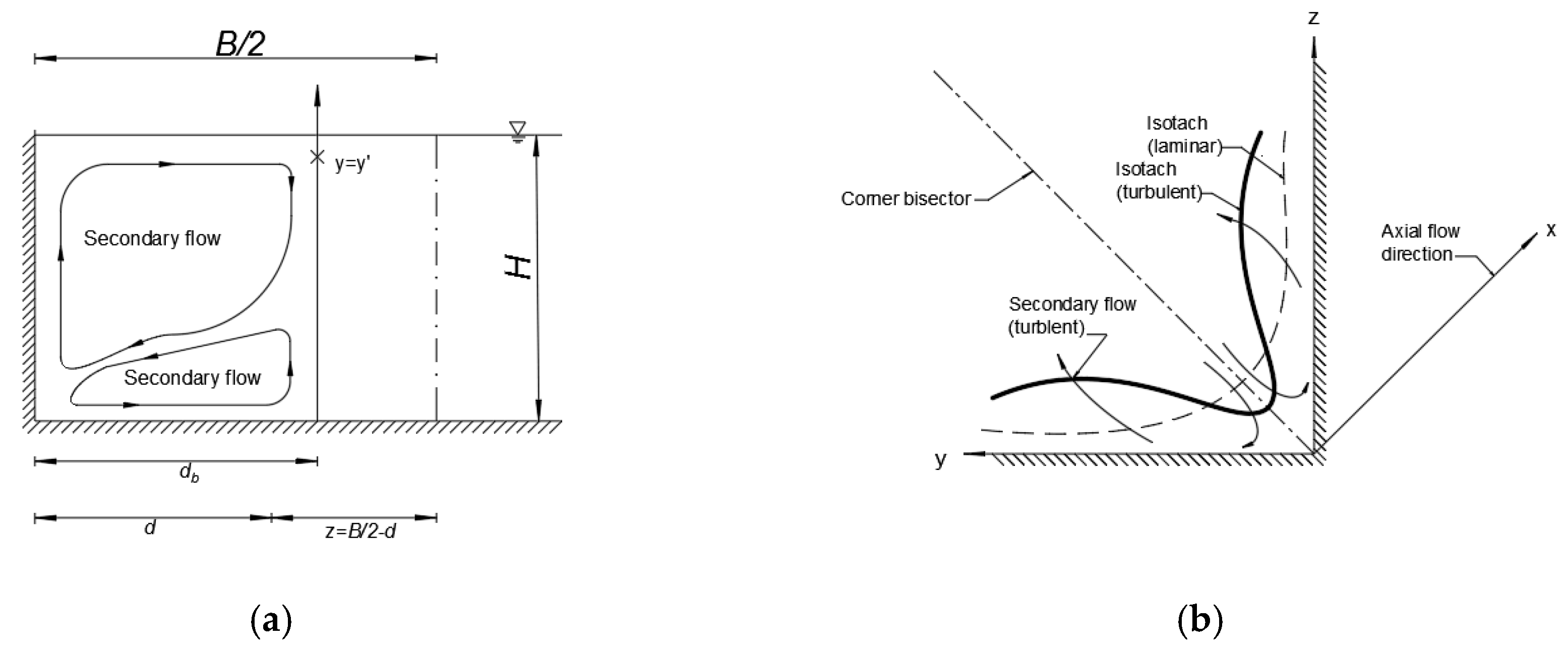



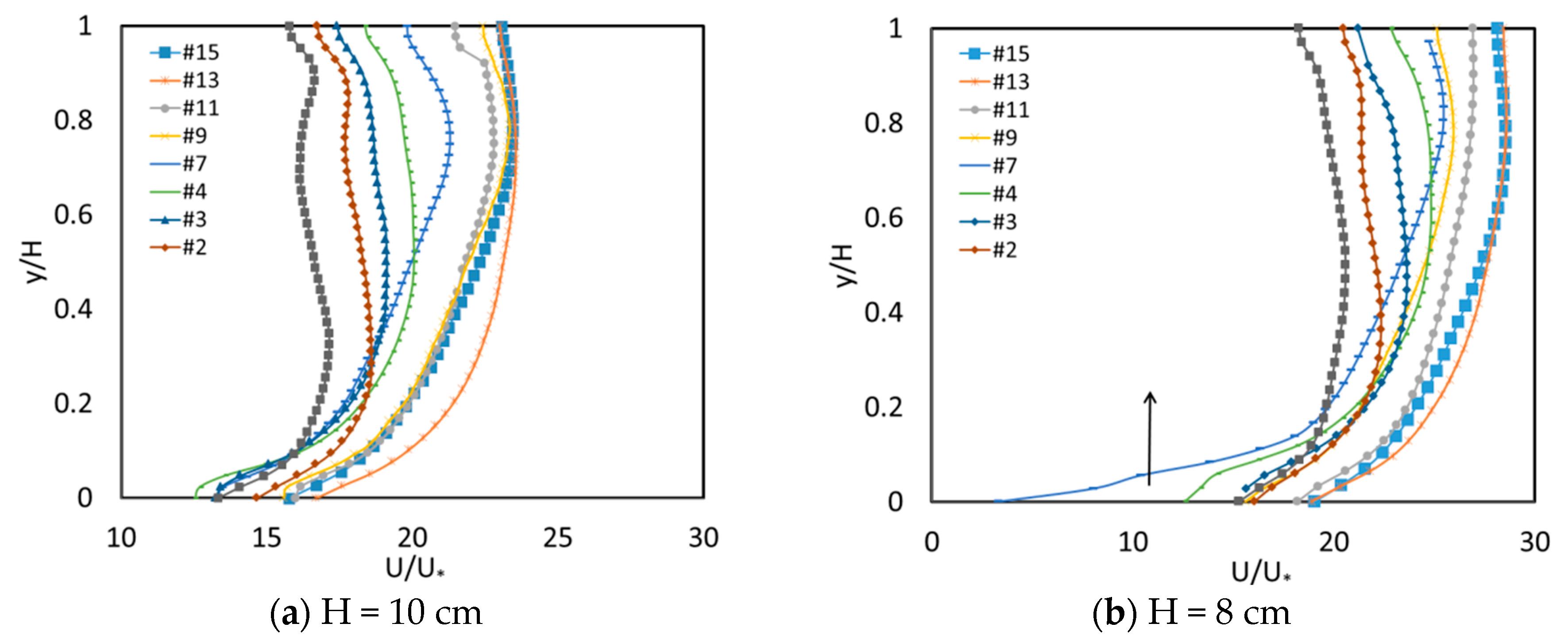
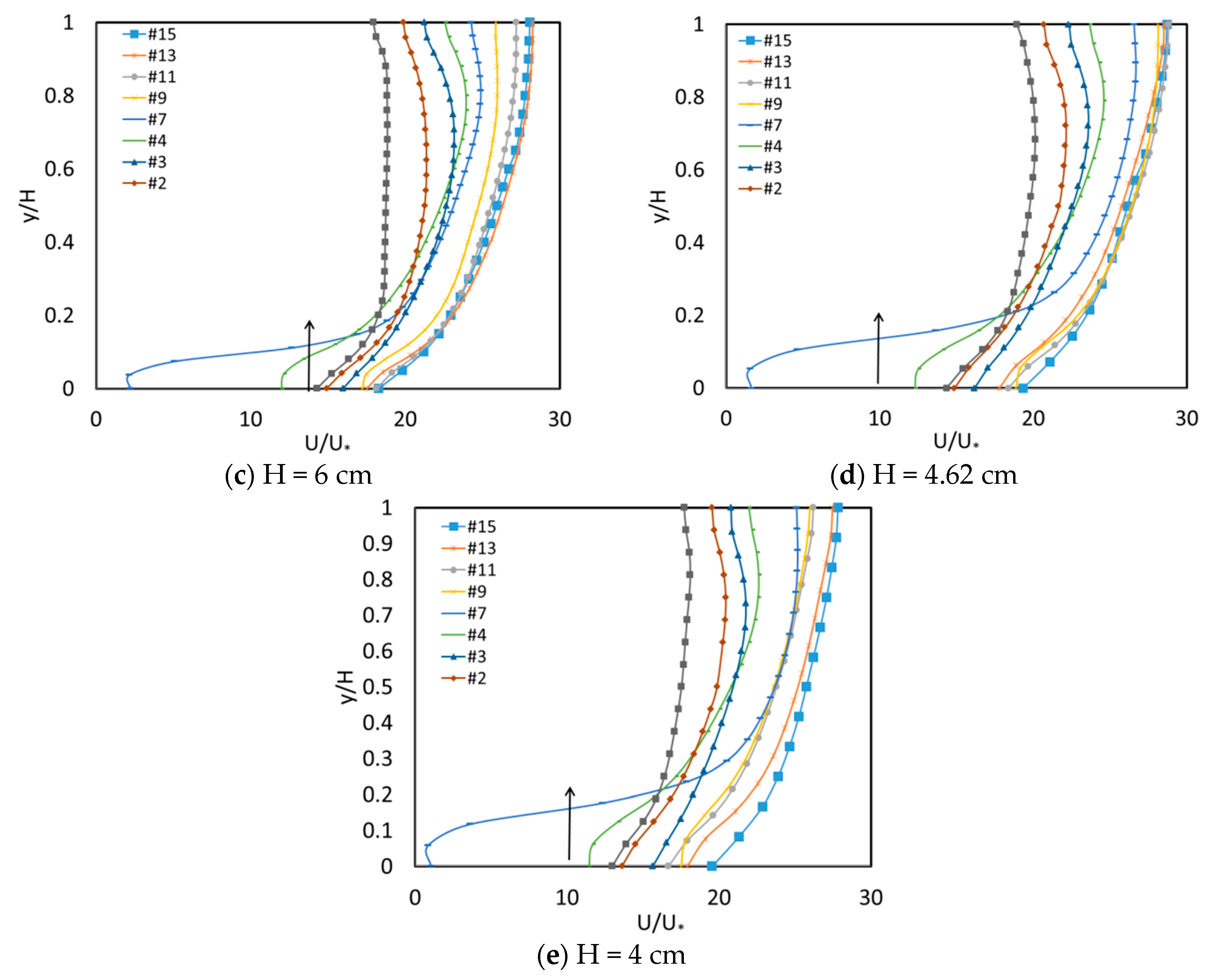
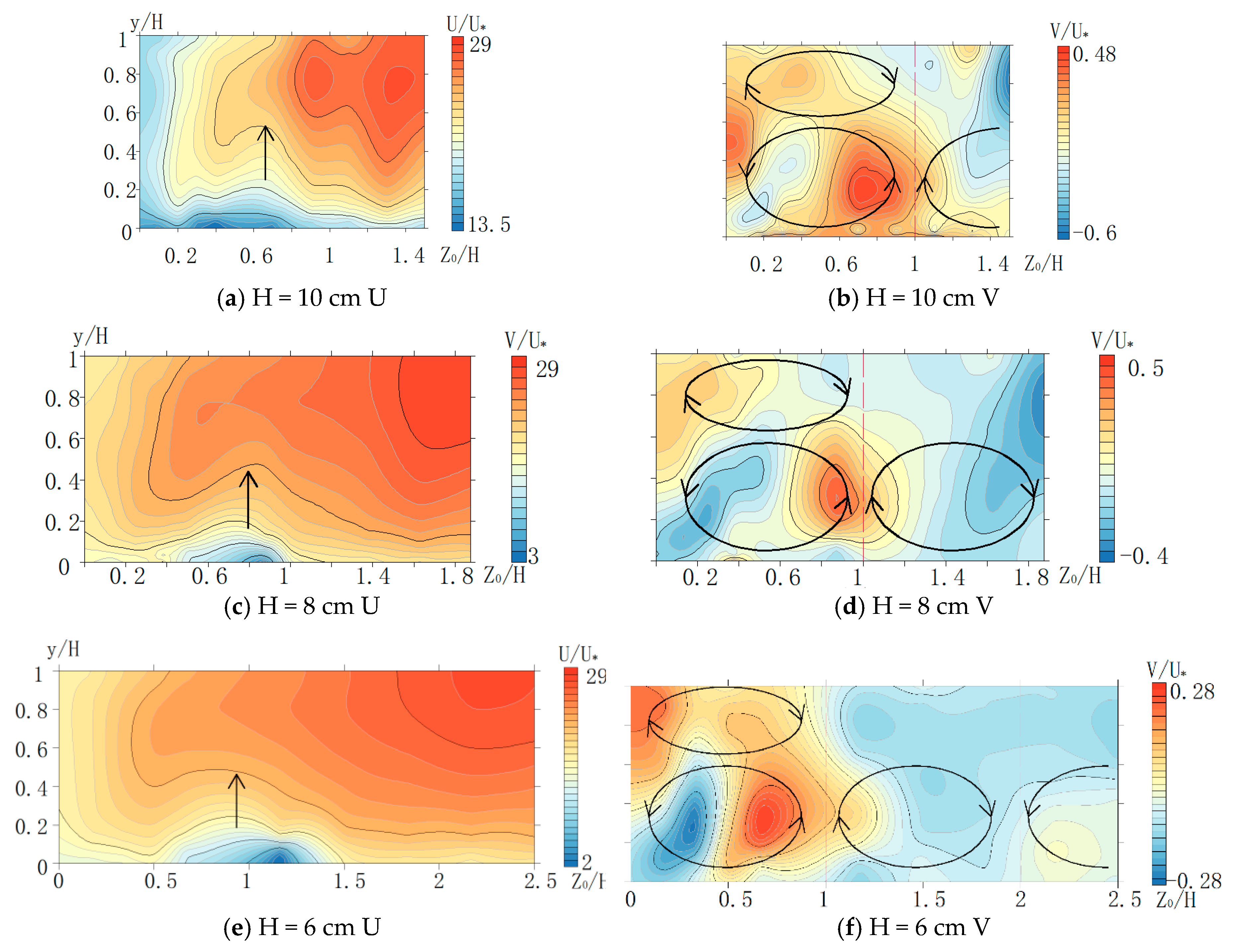

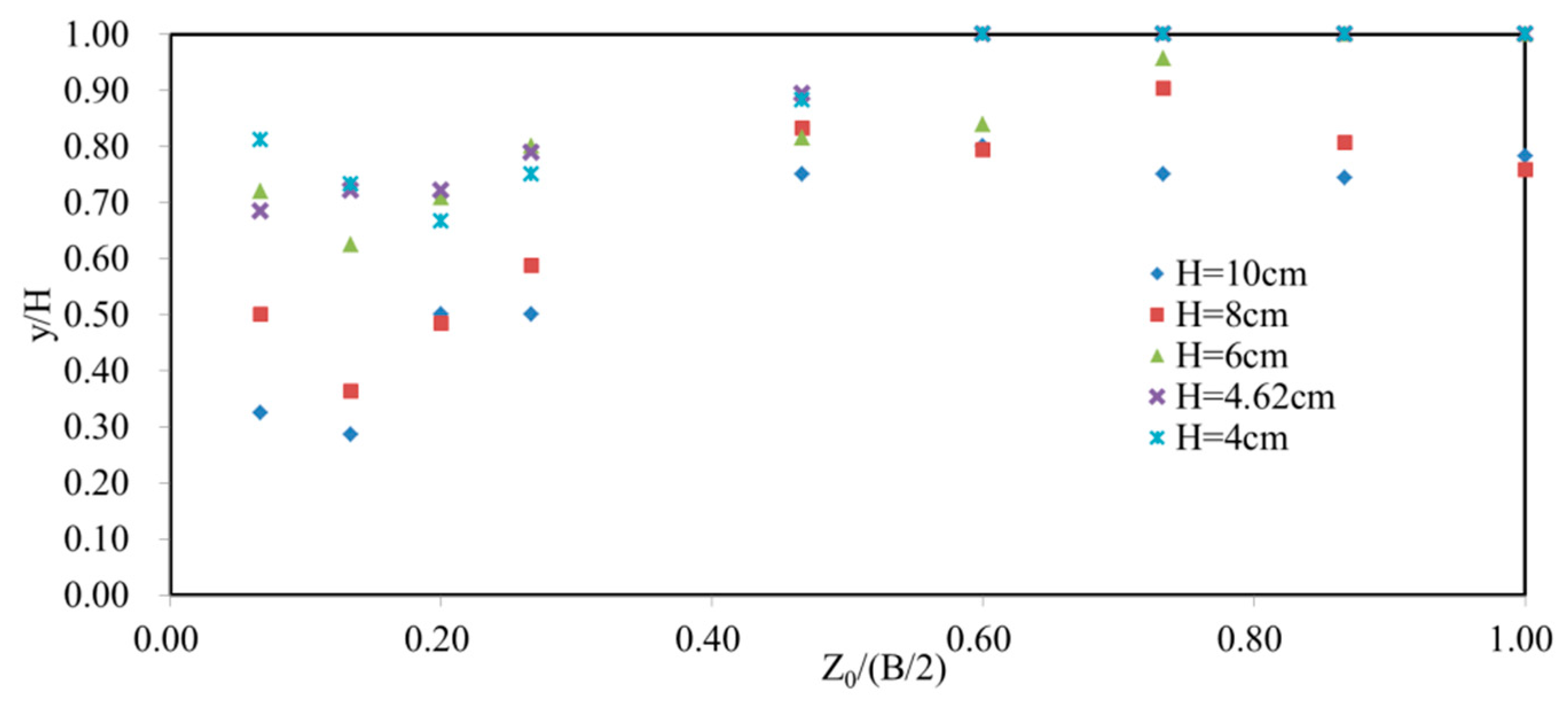
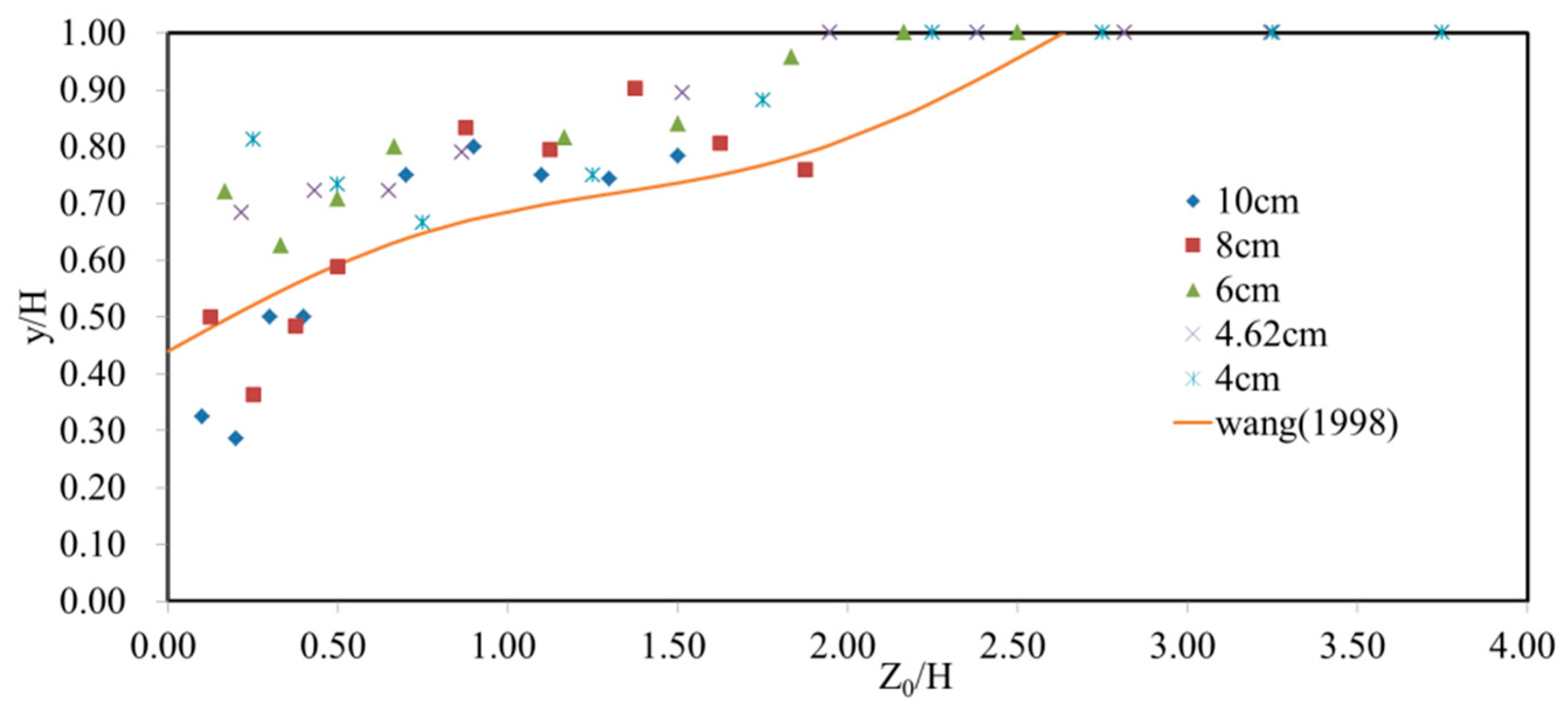
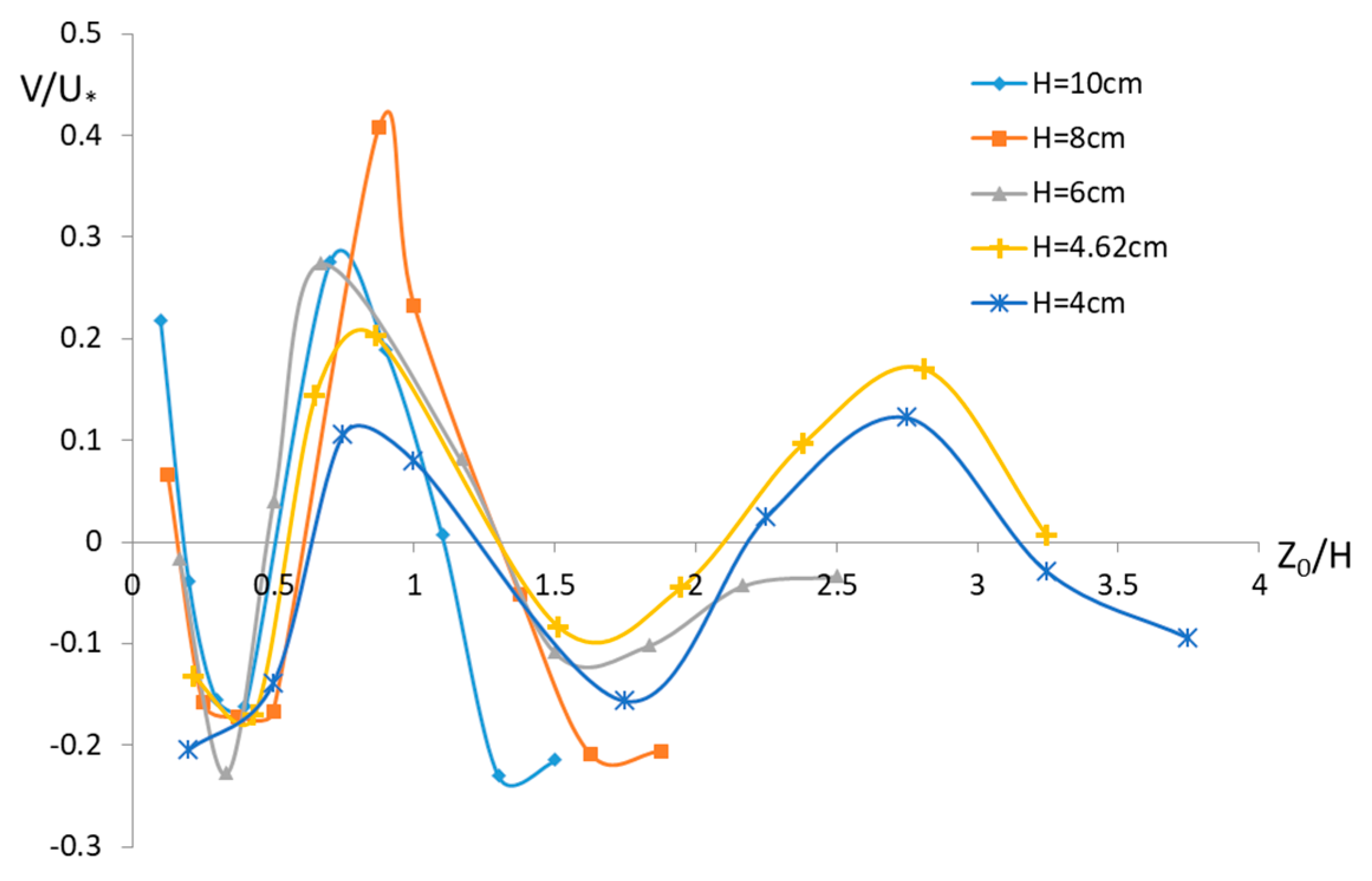
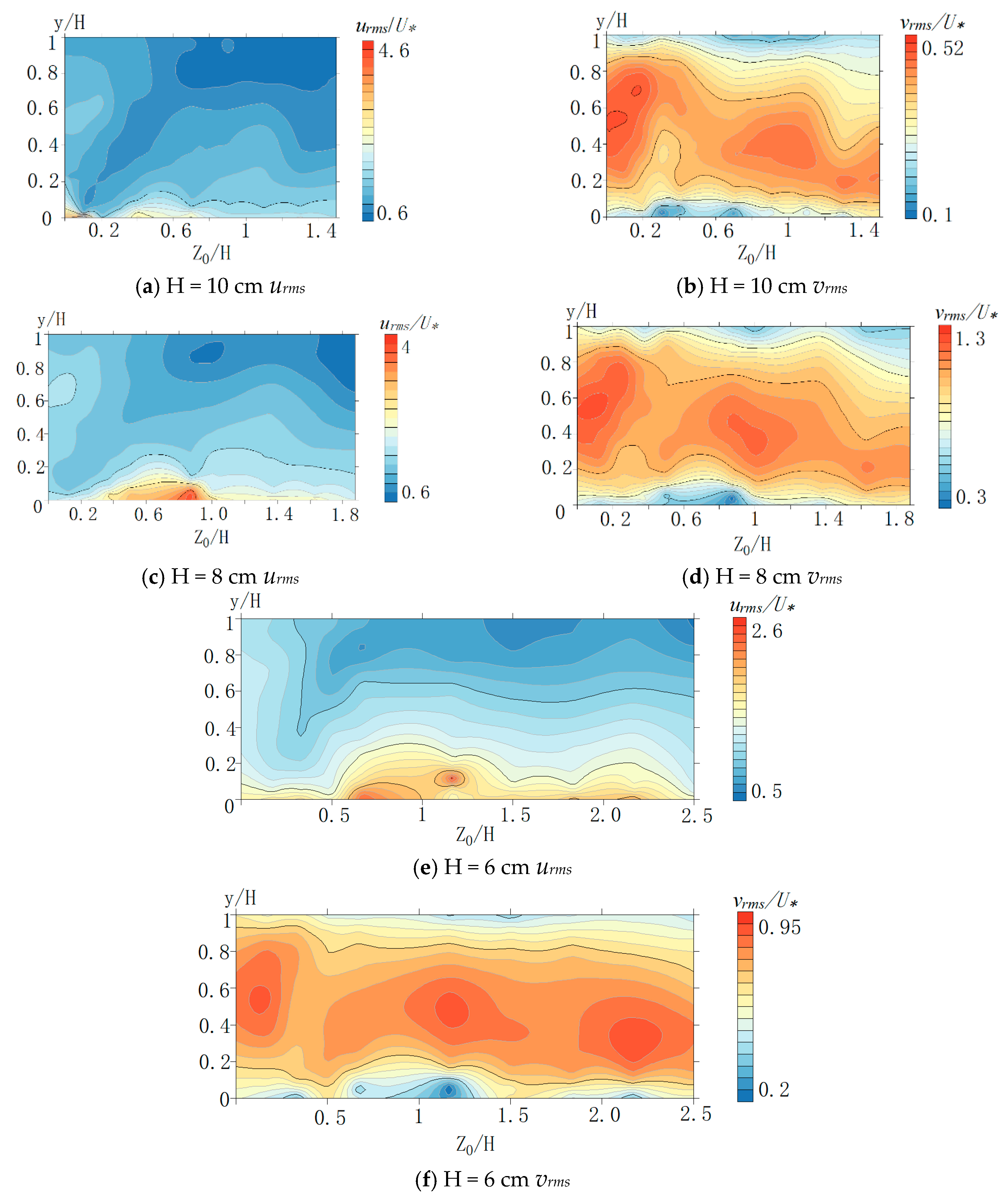
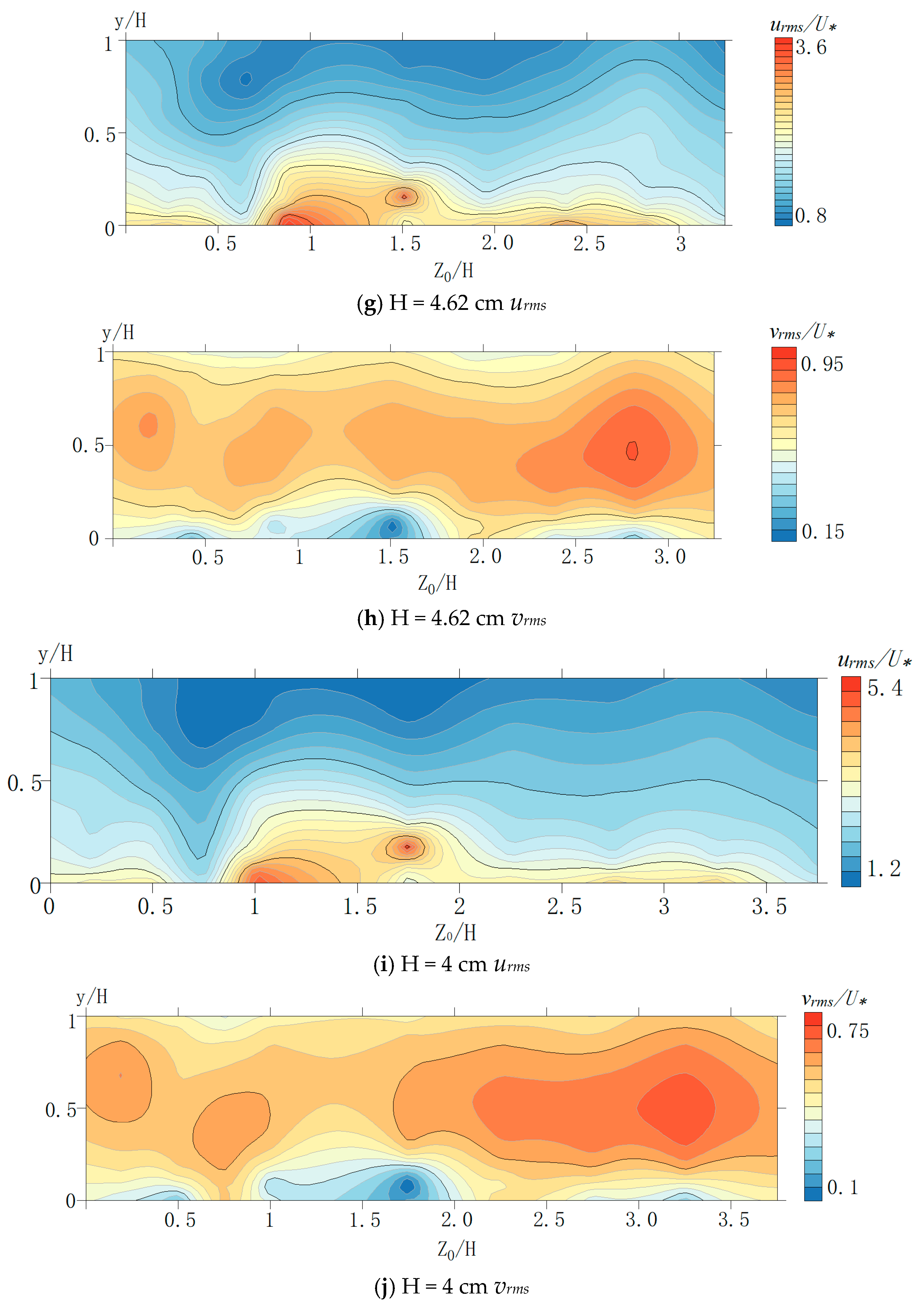
| Case | H (cm) | Ar | Q (m3/h) | ||||
|---|---|---|---|---|---|---|---|
| 1 | 10 | 3 | 138.9 | 1.2861 | 0.0542 | 1.2992 | 76,402.64 |
| 2 | 8 | 3.75 | 104.8 | 1.2130 | 0.0506 | 1.3699 | 62,658.44 |
| 3 | 6 | 5 | 68.8 | 1.0617 | 0.0458 | 1.3846 | 50,552.67 |
| 4 | 4.62 | 6.5 | 47.9 | 0.9600 | 0.0416 | 1.4267 | 37,130.11 |
| 5 | 4 | 7.5 | 38.3 | 0.8866 | 0.0393 | 1.4260 | 30,015.53 |
© 2019 by the authors. Licensee MDPI, Basel, Switzerland. This article is an open access article distributed under the terms and conditions of the Creative Commons Attribution (CC BY) license (http://creativecommons.org/licenses/by/4.0/).
Share and Cite
Jing, S.; Yang, W.; Chen, Y. Smooth Open Channel with Increasing Aspect Ratio: Influence on Secondary Flow. Water 2019, 11, 1872. https://doi.org/10.3390/w11091872
Jing S, Yang W, Chen Y. Smooth Open Channel with Increasing Aspect Ratio: Influence on Secondary Flow. Water. 2019; 11(9):1872. https://doi.org/10.3390/w11091872
Chicago/Turabian StyleJing, Siyu, Wenjun Yang, and Yue Chen. 2019. "Smooth Open Channel with Increasing Aspect Ratio: Influence on Secondary Flow" Water 11, no. 9: 1872. https://doi.org/10.3390/w11091872
APA StyleJing, S., Yang, W., & Chen, Y. (2019). Smooth Open Channel with Increasing Aspect Ratio: Influence on Secondary Flow. Water, 11(9), 1872. https://doi.org/10.3390/w11091872




